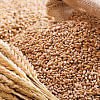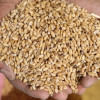Comes wonder wheat

It's a double delight for wheat growers in Bangladesh.
They can now rejoice for having a variety that is resistant to fungal disease “wheat blast” and also rich in zinc -- a crucial micronutrient that helps eradicate childhood stunting.
Scientists at the Wheat Research Centre (WRC) in Dinajpur have long been trying to develop a homegrown wheat variety that would be rich in zinc content.
HarvestPlus, a global biofortification mission launched in 2004 under the Washington-based Consultative Group on International Agricultural Research, provided WRC with the much-needed support.
And a wheat line -- BAW 1260 -- was almost ready for release as a variety with promise of containing 55 parts per million zinc as against 40 ppm in other existing varieties.
But then wheat blast struck Bangladesh for the first time early last year and again had a recurrence early this year, damaging substantial wheat acreage.
Scientists at WRC started rebreeding the promising wheat line so that they could develop a variety rich in zinc and also resistant to blast. And success came their way.
Convinced, the National Seed Board (NSB) gave approval to the new variety last week naming it as “Bari Gom-33”.
With a high yield potential (4.6 tonnes per hectare), Bari Gom-33 is also the most promising and productive wheat variety Bangladesh has ever bred. It has got bold grain with a white amber colour, high zinc content and blast resistance. It is heat tolerant as well, meaning farmers will be able to sow and reap Bari Gom-33 late into the season.
Being a net wheat importing country, it's important for Bangladesh to have better breeds so that farmers can try augmenting domestic production. As against nearly six million tonnes of yearly wheat requirements, Bangladesh can produce just little over a million. Its per hectare wheat productivity is now hovering a little over three tonnes.
Scientists at WRC said it was crucial for them to breed a variety that would withstand blast given the fact that wheat blast's emergence in Bangladesh last year was the first case of such attack anywhere in Asia.
Caused by a fungus, Magnaporthe oryzae, wheat blast is one of the most fearsome and intractable wheat diseases. It was first discovered in Brazil in 1985.
The first ever wheat blast attack in Bangladesh cost the country a financial loss of at least Tk 1,800 crore in terms of lost yield last year. It affected 1,08,715 hectares of wheat fields in Jessore, Kushtia, Chuadanga, Meherpur, Jhenidah, Magura, Barisal and Bhola, damaging up to 40 percent crop.
Mexico-based International Maize and Wheat Improvement Centre (CIMMYT) raised an alarm when blast started attacking Bangladesh's wheat fields as millions of farmers in South Asia depend on wheat farming for a living.
Parliament has recently passed a bill to upgrade WRC, currently a centre under Bangladesh Agricultural Research Institute (BARI), to an independent institute.
BARI Director General Abul Kalam Azad told The Daily Star, “It's a great achievement for us and we have taken initiatives for quick seed multiplication and rapid dissemination of this variety to the farmers' field to combat the threat of wheat blast in Bangladesh. This year we will provide 20kg seed to the BADC [Bangladesh Agricultural Development Corporation] and also limited number of demonstration through the DAE [Department of Agricultural Extension]”
Talking to this correspondent yesterday, WRC Director Naresh Chandra Deb Barma said, “Development of a variety is a continuous process and top research priority has been given to develop a high yielding blast resistant variety in collaboration with national and international partners like CIMMYT.”
He said the wheat line that has been officially released as Bari Gom-33 on Wednesday was developed through hybridization between two wheat varieties at CIMMYT, Mexico and then HarvestPlus provided materials helping out enhancing its zinc uptake capacity from the soil.
Following evaluation and selection in different generation, Naresh explained, the field performance of the line was studied for four years across different growing environments of Bangladesh and finally a line called BAW 1260 was found to be the most promising.
The variety has been tested in the United States at a lab run by the US Department of Agriculture (USDA) under artificially inoculated conditions in 2016 and 2017 and the variety consistently showed good level of resistance to wheat blast in two independent greenhouse evaluations.
The variety also didn't show any sign of blast infection when field tested in Jessore in 2016 and 2017.
Khairul Bashar, HarvestPlus country manager in Bangladesh, said higher zinc content in wheat and rice varieties would help redress micronutrient deficiencies in a large number of people and eradicate stunting and malnutrition.
Back in 2013, Bangladeshi scientists developed the world's first zinc-rich rice with HarvestPlus as partner. HarvestPlus founder Howarth Bouis was accorded World Food Prize last year for his contribution in spreading the biofortification movement across countries in Asia and Africa.
Biofortication is the process by which the nutritional quality of food crops is improved through agronomic practices, conventional plant breeding, or modern biotechnology.

 For all latest news, follow The Daily Star's Google News channel.
For all latest news, follow The Daily Star's Google News channel. 








Comments